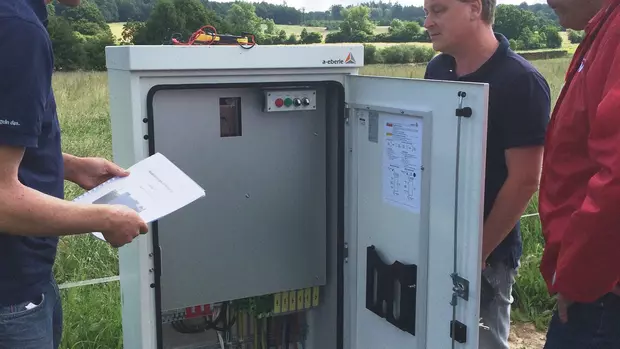
regler in Betrieb.
Mittelhessen Netz GmbH (MIT.N) recently installed a so-called longitudinal voltage regulator in Wermertshausen, a district of Ebsdorfergrund. This familiar technology is currently finding a new application. This is because more and more photovoltaic and wind energy systems are feeding electricity into the grid. However, because these energy sources are sometimes extremely volatile, system components are needed to compensate for the resulting fluctuations in voltage.
The location of the new series voltage regulator is almost ideal. It is located in a power supply line to a drinking water pumping station. "This spur line is around 1300 metres long. With such cable lengths, the problems caused by voltage fluctuations become very apparent," explains Frank Hoffmann, Managing Director of MIT.N. This is why he and project manager Martin Hajdu decided to install the modern unit. "Such a longitudinal voltage regulator costs much less than a controllable local transformer and in this particular case probably gives us significantly better results," says Frank Hoffmann happily. Even reinforcing the line would not solve the problem as well technically - not to mention financially. Another advantage: installation and commissioning of the longitudinal voltage regulator, including set-up and adjustment, takes a maximum of two working days.
Important component
In Wermertshausen, MIT.N relies on a device from the market leader A. Eberle from Nuremberg. Housed in a compact steel casing, several electronically controlled transformers independently compensate for voltage fluctuations in the range of plus/minus ten per cent. "This mode of operation makes series voltage regulators important components of an intelligent power grid and therefore building blocks for the success of the energy transition," continues Frank Hoffmann.
Over the next few months, the experts at MIT.N will gain important experience with their new longitudinal voltage regulator. This is because new solar and wind power plants are still being built in Central Hesse. This inevitably increases the voltage fluctuations in the grid and therefore the need to compensate for them. "I assume that we will install one or two more such devices," predicts Frank Hoffmann. After all, the expansion of renewable energy in the region should not fail because of the electricity grid.

